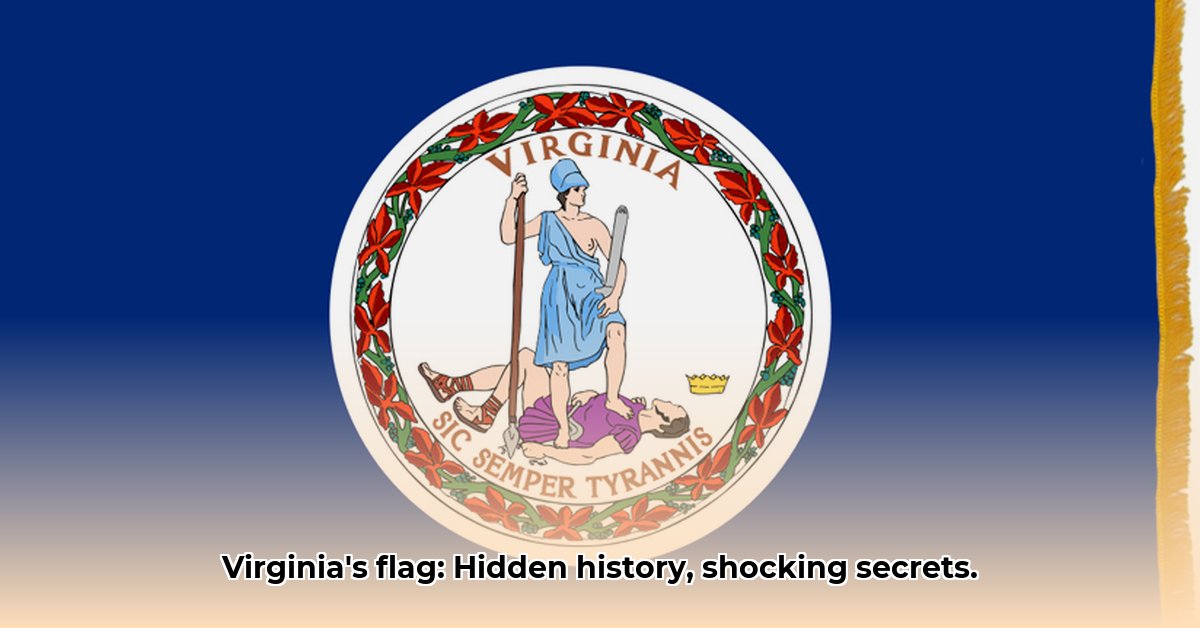Ever wonder about the story behind Virginia’s state flag? It’s more than just a pretty picture; it’s a time capsule packed with history, meaning, and even a bit of controversy. This article dives into the flag’s journey, from its revolutionary roots to the debates it sparks today. We’ll uncover the secrets behind its symbols – like the figure of Virtus and the debated motto “Sic Semper Tyrannis” – and explore how different people have interpreted them over the years. For a deeper dive, check out this helpful resource on Virginia’s flag.
The Virginia State Flag: Unpacking History, Symbolism, and Controversy
The Virginia state flag is a lens through which we can view the state’s complex history. Officially adopted in 1950, its core image depicts Virtus, the Roman goddess of virtue, standing triumphantly over Tyranny. This scene represents Virginia’s struggle for freedom, but the story is more nuanced than a simple victory narrative. Understanding the flag requires exploring its evolution, diverse interpretations, and the historical context in which it was created and used.
Revolutionary Roots and Roman Republic Inspiration
The flag’s imagery, conceived long before its official adoption and dating back to at least 1861, embodies ideals of liberty and perseverance. Virtus, with her foot on Tyranny, represents the spirit of the American Revolution, while the broken chains and whip symbolize the overthrow of British rule. The motto “Sic Semper Tyrannis,” meaning “Thus always to tyrants,” is a declaration of freedom, possibly alluding to the assassination of Julius Caesar. The seal makers purposefully drew inspiration from the Roman Republic, rejecting British heraldry and signifying a shift away from monarchy. This conscious decision reflects the values of the Virginian leaders at the time.
Symbolism Under Scrutiny: Virtus, Tyranny, and Interpretation
While the core symbolism is generally agreed upon, specific details spark debate. Virtus’s exposed breast, for instance, generates diverse reactions. Some see it as a reflection of classical art, while others find it inappropriate or even offensive, leading to calls for design modifications. Tyranny’s depiction also invites interpretation: who or what does he truly represent? These differing interpretations highlight the subjective nature of visual symbols and the importance of considering multiple perspectives.
The Civil War Era: A Complex Legacy
The flag’s use during the Civil War adds another layer of complexity. As the flag flew during a period of secession, some argue that it inadvertently supports the Confederate cause, regardless of the original intent. This association has fueled ongoing debate about the flag’s modern relevance and whether it accurately represents Virginia’s values today. The historical context of the Civil War significantly shapes modern perceptions of the flag and its symbolism, creating a complex legacy that must be acknowledged.
Evolution and Standardization: Adapting Over Time
The Virginia state flag hasn’t remained static throughout history. Its design has undergone refinements and standardization over the years, reflecting efforts to address inconsistencies and evolving interpretations. These changes demonstrate a continuous effort to clarify its meaning and address concerns about potential misinterpretations. The standardization efforts, particularly in the early 20th century, attempted to create a unified visual identity for the state.
Modern Controversies and Ongoing Dialogue
Controversies surrounding the Virginia state flag highlight the challenges of interpreting historical symbols in a contemporary context. These symbols are not static; they reflect our past and shape our present and future. Incidents like the flag’s temporary ban in a Texas school district demonstrate its continuing relevance and its place in current political discussions. Understanding these modern controversies requires acknowledging the evolving social and political landscape.
Fostering Respectful Dialogue and Seeking Common Ground
The debate surrounding the Virginia state flag provides an opportunity for thoughtful discussion about history, symbolism, and collective identity. How do we celebrate past achievements while acknowledging the complexities of the past? How can we foster a more inclusive understanding of state symbols, recognizing both their positive and negative aspects? These questions require careful consideration and a commitment to respectful dialogue.
| Stakeholder Group | Short-Term Actions (0-1 year) | Long-Term Actions (3-5 years) |
|---|---|---|
| Virginia Government | Review and update flag display regulations, addressing concerns about potential Confederate links. | Facilitate public discussions, possibly review all state symbols comprehensively. Establish a commission to study the flag’s history and symbolism. |
| Historians & Educators | Create educational resources that contextualize the flag’s history, highlighting both positive and negative aspects. | Conduct in-depth research into the flag’s design and historical usage. Develop curriculum materials that promote critical thinking about historical symbols. |
| Citizens of Virginia | Engage in open and respectful discussions. Participate in educational programs on the flag’s history. | Promote mutual understanding and acceptance of differing opinions about the flag’s symbolism. Organize community forums to discuss the flag’s meaning and relevance. |
| Other States/Entities | Learn from Virginia’s experiences. | Collaborate to develop best practices for handling potentially controversial state symbols. Share resources and information on the history and symbolism of state flags. |
The story of the Virginia state flag remains unfinished. It is a symbol that continues to evolve, reflecting and shaping conversations about Virginia’s identity and its place in American history. The debates surrounding it remind us that history is complex and that our interpretations of symbols can change over time.
Interpreting the Symbolism of Virginia’s State Flag
Key Takeaways:
- Virginia’s state flag is not just a piece of cloth; it reflects the state’s values and identity.
- The flag’s design incorporates historical and artistic elements with layered meanings.
- The central figure, Virtus, and motto, “Sic Semper Tyrannis,” are at the heart of the controversy.
- Understanding requires examining the evolving interpretations within their historical context.
- The flag’s design has changed over time, reflecting shifting cultural values and interpretations of Virginia’s past.
Virtus: Classical Ideal or Modern Offense?
The flag centers on Virtus, representing virtue and strength. Depicted in classical style, Virtus is often shown partially nude. This depiction is at the heart of the flag’s controversy. Some view the imagery as a reflection of artistic tradition and symbolic representation, while others find it jarring and even offensive. This disagreement highlights changing social norms and interpretations of historical symbolism.
The question is: How do we reconcile the historical context of the art style with modern sensibilities? By acknowledging diverse interpretations and promoting respectful dialogue, we can navigate this complex issue.
“Sic Semper Tyrannis”: Legacy of Liberty or Violent Rhetoric?
The motto, “Sic Semper Tyrannis,” adds another layer to the debate. Translated from Latin, it means “Thus Always to Tyrants.” Originally adopted by the state prior to the Civil War, this motto gained a dark connotation following Lincoln’s assassination. John Wilkes Booth reportedly shouted the phrase, intertwining it with a violent act that provokes strong emotional reactions.
This association casts a shadow over the interpretation of the motto. It raises questions about the relationship between revolutionary ideals and acts of violence. Understanding this context is crucial for interpreting the flag’s message.
Evolution: From Confederacy to Contemporary Concerns
The current design follows a lineage reflecting Virginia’s turbulent past. Earlier iterations often incorporated more militaristic elements, further linking the flag to Confederate symbolism. The 1930s witnessed a significant effort to standardize the state seal and flag design.
Understanding this evolution shapes how to interpret the symbolism of the flag. It reveals the changing priorities and values of the state over time. Paying attention to these changes is essential for informed discussion.
Navigating Nuances: Perspectives and Interpretations
To understand the Virginia state flag, appreciate the multiplicity of viewpoints. The flag’s symbolism elicits diverse emotions. Acknowledging this spectrum of reactions is crucial. Engage with the historical context, the artistic style, and the evolving cultural landscape to engage in informed discussion.
How do we reconcile historical relevance with contemporary sensitivities? By embracing a nuanced understanding of the flag’s symbolism, we can foster respectful dialogue and seek common ground.
















